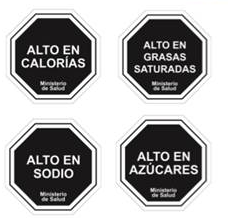Background
Chile has undergone major demographic, epidemiological, and nutrition transitions over the past 50 years1 and currently has the highest prevalence of obesity in Latin America.2 Non-communicable diseases (NCDs) account for 83% of all deaths in Chile, for which over-nutrition and obesity are both major determinants.3 Massive increases in sugar-sweetened beverage (SSB) consumption has helped fuel these trends:
- From 2009-2014, Chile saw the fastest absolute growth of SSB sales in the world.4
- In 2014, Chile had the highest per-person daily calories sold from SSBs in the world.1
Regulations
To combat these trends in diet, body composition, and NCD deaths, Chile is implementing the most comprehensive set of obesity-preventive regulations to date in the world. Staggered implementation of these regulations will allow for evaluation of their independent and joint impacts.
- October 2014: 8% tax on SSBs relative to other beverages
- July 1, 2016: Foods and beverages with added sugars, sodium, saturated fats or calories that exceed set thresholds are subject to:
- Front-of-package warning labels (on packaged products)

- Marketing restrictions:
- Cannot use child appeals* in any marketing or advertisements * e.g., licensed or brand characters, toys or giveaways, child-targeted graphic style
- Cannot advertise on TV programs or websites targeting children (≤14y)
- Cannot advertise on TV programs or websites where children (≤14y) make up >20% of audience
- Front-of-package warning labels (on packaged products)
- 2017: Advertising ban extended to all TV programming and cinema from 6am–10pm
- Future: Considering implementing a “mega-tax” on processed foods/beverages
- UNC providing simulation studies to examine different tax options (i.e. whether to tax sugar specifically, nonessential foods and beverages, or link it to marketing law)
Read and download the regulations in Spanish:
- Ley 20.780 (Beverage Tax Law)
- Ley 20.606 (Advertising Law)
- Ley 20.869 (Food Marketing Law)
Read and download the regulations in English:
- Law 20.780 (Beverage Tax Law)
- Law 20.606 (Advertising Law)
- Law 20.869 (Food Marketing Law)
Read more about our Evaluation Design here, and our Collaborators here.
Funding
This work was supported by a grant from International Development Research Center (IDRC Grant # 107731 and #108180), CONICYT Fondecyt #1161436, Bloomberg Philanthropies, and by the Carolina Population Center (CPC P2C HD050924).
References
- Bambs C, Cerda J, Escalona A. Morbid obesity in a developing country: the Chilean experience. World Health Organization. October 2008. Available athttp://www.who.int/bulletin/volumes/86/10/07-048785/en/. Accessed May 2016
- Ng, M., et al. Global, regional, and national prevalence of overweight and obesity in children and adults during 1980-2013: A systematic analysis for the global burden of disease study 2013. The Lancet, 384(9945), 766-81. doi:http://dx.doi.org/10.1016/S0140-6736(14)60460-8
- Salomon, J.A., et al. Healthy life expectancy for 187 countries, 1990–2010: a systematic analysis for the Global Burden Disease Study 2010. The Lancet, 2012. 380(9859): p. 2144-2162.
- Popkin BM, Hawkes C. Sweetening of the global diet, particularly beverages: Patterns, trends, and policy responses. Lancet Diabetes Endocrinol. 2015;4(2):174–186. doi:10.1016/S2213-8587(15)00419-2.
This support comes primarily from Bloomberg Philanthropies with additional support from IDRC and CONICYT.
